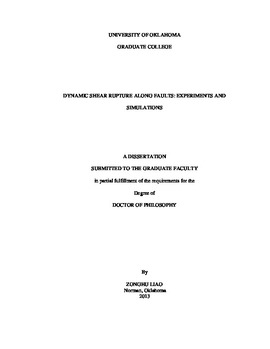| dc.description.abstract | Earthquakes are events of unstable shear rupture that propagate along fault-zones in the crust. Earthquake rupture processes have been the focus of experimental analyses and numerical simulations, yet many details are still enigmatic (Ch.1). One of the central questions of earthquake physics is the intensity of fault dynamic weakening, and the realistic simulation of earthquake rupture at in-situ conditions. My main focus in rupture simulations is the dependence of the simulations on the friction law of the fault interface that is based on experimental observations.
In recent years, experimental results of high-velocity shear provided a promising opportunity to implement experimental friction model to dynamic rupturing on earthquake scale. The main issues related to earthquake processes at seismic and aseismic rates are reviewed in Ch. 2, with emphasis on friction strength data from rotary shear apparatus and its potential application to the rupture numerical simulation.
Then, I present my experimental results for siliceous igneous rocks at high slip velocity (up to ~1.0 m/s) and at normal stress of ~1-7MPa. The evaluation of these and others steady-state experiments suggests that this data may be irrelevant to fault friction during earthquakes, simply because earthquake slip does not occur as a steady-state process. To avoid the limitation of controlled velocity in steady-state experiments, I tested the earthquake-like loading experiments. It presents the fast-accelerated and slow-decelerated behavior of slip velocity, and the weakening-strengthening of shear stress, which better captures the character of earthquake rupture models and comply with the earthquake models (Ch. 3).
Based on the formulations of dynamic shear rupturing for earthquake simulations (Ch. 4), I simulate the dynamic shear rupture along a vertical, strike-slip fault in an elastic half-space (Ch. 5). The fault has the frictional strength properties that were determined experimentally on Sierra White granite samples at impact loading. The friction-distance relations of these experiments were used to form an empirical slip-dependent friction model, referred to as ‘Earthquake-like-slip-even’ ELSE-model (Chang et al., 2012). For the dynamic rupture simulation, I used a 2D spectral boundary integral element method that was designed for anti-plane (mode III) shear fracture problems (Ampuero, 2002). To facilitate comparison of ELSE-model results with published models, the calculations were conducted for a crust with mechanical properties and stress state of Version 3 benchmark of SCEC (Harris et al., 2004).
The rupture simulations with a fault of ELSE-model friction law revealed a few significant properties: (1) Rupture propagation in a slip-pulse style in which the slip velocity with the cessation of slip behind the slip-pulse; (2) Systematic decrease of slip distance away from the nucleation zone; and (3) Spontaneous arrest of the dynamic rupture without requiring artificial insertion of a barrier. These properties suggest a rupture of a self-healing slip-pulse mode in contrast to the rupture model calculated for linear slip-weakening friction (Rojas et al., 2008) that generates a crack-like rupture with no spontaneous arrest. I deduce that the slip-pulse in our simulation results from the fast recovery of shear strength as observed in ELSE experiments, and argue that incorporating this experimental-based friction model to rupture modeling produces realistic propagation of earthquake rupture.
Finally, I also investigate a structural problem of identification of a strike-slip fault at the subsurface (Ch. 6). I used wet clay experiments to analyze the evolution of the associated structures with a strike-slip fault in the Woodford Shale unit, Anadarko basin, Oklahoma. The geometry of Riedel shears, splay shears and P shears from the lab are used as proxies for the 20 mi long, north-south strike slip fault in the 3D seismic survey volume. I applied three seismic attributes (coherence, dip-azimuth, and curvature) to illuminate the fault system, and identify two types of associated structures with high intensity of fractures for potential horizontal drilling: (1) fault systems that are similar to the clay experiments that were revealed in coherence maps; and (2) anticlinal folds that were detected in curvature maps. I conclude that combining attribute analysis and experimental observations strengthens the identification of this striking slip fault-zone in Woodford Shale. | en_US |
